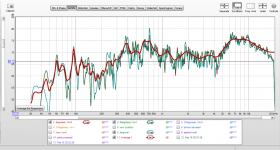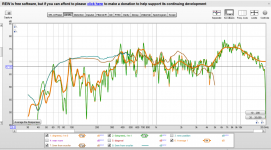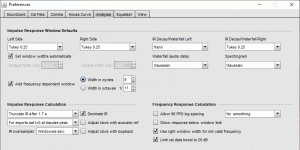Hello everyone!
I am new to this community and just started a loudspeaker build.
It is a 2 way design with a 6" Dayton Reference RS150-4 and a Dayton 1" tweeter with a 2nd order butterworth crossover at 3.5kHz. The vented enclosure is Vb = 14.7L with a 3" flared port Fb = 41Hz.
I took my first measurements using a Dayton Audio EMM measurement mic and am really confused with what I am seeing. I am not expecting a perfectly flat response but I am trying to get it pretty close.
I have attached the SPL measurements of a single loudspeaker at 1M on axis.
I am aware that my tweeter is more sensitive than the woofer and I am making the fix soon. What confuses me is the massive dip at around 180Hz. I am stuck trying to figure out the problem.
I was wondering if it was port noise, resonance, room issues but I am not able to figure it out. Please let me know if any further measurements/info are required.
Thank you
I am new to this community and just started a loudspeaker build.
It is a 2 way design with a 6" Dayton Reference RS150-4 and a Dayton 1" tweeter with a 2nd order butterworth crossover at 3.5kHz. The vented enclosure is Vb = 14.7L with a 3" flared port Fb = 41Hz.
I took my first measurements using a Dayton Audio EMM measurement mic and am really confused with what I am seeing. I am not expecting a perfectly flat response but I am trying to get it pretty close.
I have attached the SPL measurements of a single loudspeaker at 1M on axis.
I am aware that my tweeter is more sensitive than the woofer and I am making the fix soon. What confuses me is the massive dip at around 180Hz. I am stuck trying to figure out the problem.
I was wondering if it was port noise, resonance, room issues but I am not able to figure it out. Please let me know if any further measurements/info are required.
Thank you
Attachments
180hz has a wavelength of just over 6.25ft (1.9m), this may give a clue as to whether it is a resonance i.e. you have walls/ceiling etc in multiples of this.
Try taking a reading about 1cm from the dome on the woofer and then add it to the overall 1m distance measurement splicing it at around 500hz (taking into account the volume difference).
Try taking a reading about 1cm from the dome on the woofer and then add it to the overall 1m distance measurement splicing it at around 500hz (taking into account the volume difference).
To measure correctly a speaker, you need an anechoic chamber, as you want to measure only what is coming directly from the speaker and not all the reflections. As nobody has such a chamber, the trick is to use a gated measure, so you tell the measurement system to stop recording just before the first reflection arrives to the mic. Depending on the chamber and setup, the gate is some few ms. As an example with a gate of 4ms you can measure correctly only what is shorter than the gate itself, so for frequencies greater than 250Hz. With a speaker at 1m from the floor and measured at 1m, the gate is around 4ms.
With the above example, if you want to know what happens under 250Hz, you need to put the mic a few mm from the dustcap so you can measure only what is coming from the woofer (because all the reflections are way lower in intensity). In this way however you won't see the the baffle step effect, so before splicing this near-field measure to the 1m far-field measure you need to calculate the effect of the baffle step and subtract this effect from the near-field measure.
Just a couple of notes on your project. The RS150 needs to be crossed over fairly low, between 2 and 2.5KHz. I'd aim at LR4 ***acoustic*** slopes for your crossover, in most cases you can reach them with a 2nd order electrical crossover on the woofer and a 3rd order electrical on the tweeter.
Ralf
With the above example, if you want to know what happens under 250Hz, you need to put the mic a few mm from the dustcap so you can measure only what is coming from the woofer (because all the reflections are way lower in intensity). In this way however you won't see the the baffle step effect, so before splicing this near-field measure to the 1m far-field measure you need to calculate the effect of the baffle step and subtract this effect from the near-field measure.
Just a couple of notes on your project. The RS150 needs to be crossed over fairly low, between 2 and 2.5KHz. I'd aim at LR4 ***acoustic*** slopes for your crossover, in most cases you can reach them with a 2nd order electrical crossover on the woofer and a 3rd order electrical on the tweeter.
Ralf
To measure correctly a speaker, you need an anechoic chamber
outdoors on a roof top, gable shaped, or high up in a tree or a pole works too
Here's a design thread on this Forum for a two way using the RS150 with the nla Dayton RS28 tweeter, it's a rather complex crossover but worth an optic to see how the designer approached the project, which is described as a 'monitor' design.
The DIYRM-A, Two way Dayton RS150P and RS28 Tweeter-60 Page Design Guide
There's also a project on Parts Express Tech Talk called "The Jonquils" which uses the RS150 with an SB tweeter and has a simpler crossover along the lines of what Ralf's talking about in the post above.
Not trying to dissuade you from doing your own measurements and own thing, just trying to provide (hopefully) useful background information to assist.
Geoff
The DIYRM-A, Two way Dayton RS150P and RS28 Tweeter-60 Page Design Guide
There's also a project on Parts Express Tech Talk called "The Jonquils" which uses the RS150 with an SB tweeter and has a simpler crossover along the lines of what Ralf's talking about in the post above.
Not trying to dissuade you from doing your own measurements and own thing, just trying to provide (hopefully) useful background information to assist.
Geoff
Last edited:
Here is a link to a comprehensive guide on getting measurements for the uninitiated. I found it very helpful and the spreadsheet is fussy but works well.
https://www.google.com/url?sa=t&sou...FjADegQIERAB&usg=AOvVaw3M67cyu_TYnjmUQECJa-5F
Good luck with your design and please keep the measurements porn coming.
https://www.google.com/url?sa=t&sou...FjADegQIERAB&usg=AOvVaw3M67cyu_TYnjmUQECJa-5F
Good luck with your design and please keep the measurements porn coming.
Thank you everyone for your replies.
@Ralf
I will definitely take your advice and change my crossover design. Could you please guide me to a resource where I can learn more about the different crossover designs and how each type affects the sound.
@Ralf
I will definitely take your advice and change my crossover design. Could you please guide me to a resource where I can learn more about the different crossover designs and how each type affects the sound.
I took some rudimentary measurements today. I was not able to splice it using my current software but I will work on that soon.
I measured the woofer from 1cm away, 30Hz - 500Hz. I overlaid it with the previous measurement I shared and the difference is very obvious.
I know the measurement is very rough at this point but is this enough info point me in the right direction as to why I have such a large dip in the 180Hz region? Is this a room issue?
I measured the woofer from 1cm away, 30Hz - 500Hz. I overlaid it with the previous measurement I shared and the difference is very obvious.
I know the measurement is very rough at this point but is this enough info point me in the right direction as to why I have such a large dip in the 180Hz region? Is this a room issue?
Attachments
Usually a reflection issue, so an odd harmonic dip = ~34400/2/180 = ~95-96 cm, such as from the center of the woofer to the floor or other parallel and/or perpendicular surface or 'floor/ceiling bounce' when measuring at a distance: Floor/Ceiling Reflection Calculator
Below 300Hz it's rather impossible to make indoors correct measurements,
you're more measuring the response of the room.
But you should alter the measurement windows width settings in REW to something like 8 cycles,
this removes some room interaction in the measurements.
Another trick is to use the REW tools Generator and RTA:
generate some noise and measure live with RTA and move the mic a bit around.
you're more measuring the response of the room.
But you should alter the measurement windows width settings in REW to something like 8 cycles,
this removes some room interaction in the measurements.
Another trick is to use the REW tools Generator and RTA:
generate some noise and measure live with RTA and move the mic a bit around.
Attachments
- Home
- Loudspeakers
- Multi-Way
- Trying to build my own loudspeakers for the first time. I need help!


